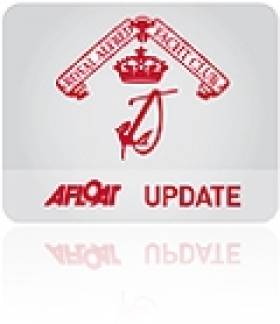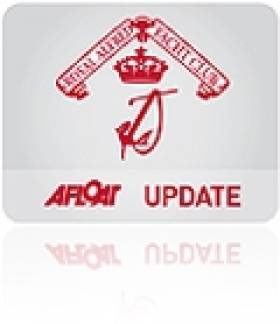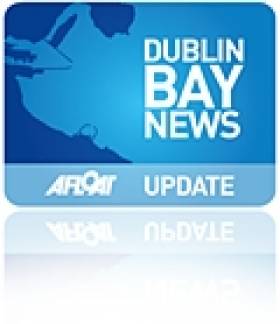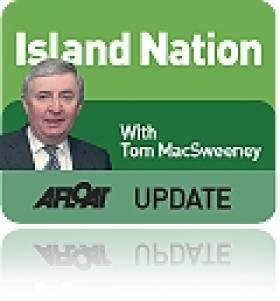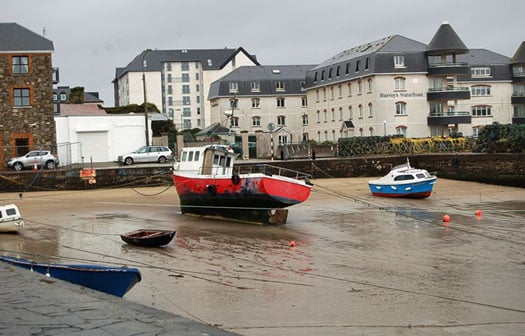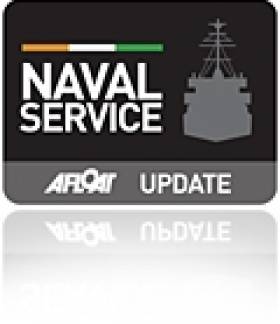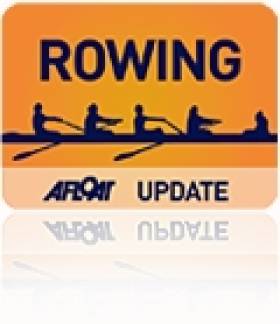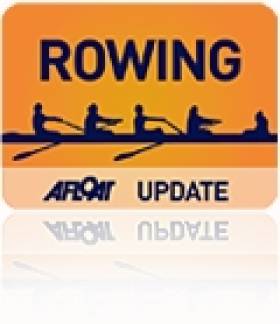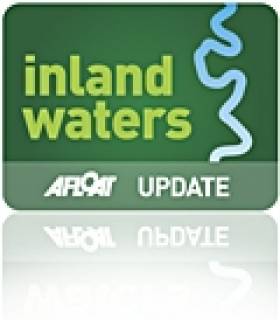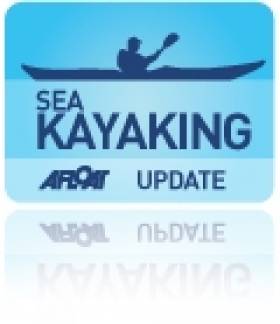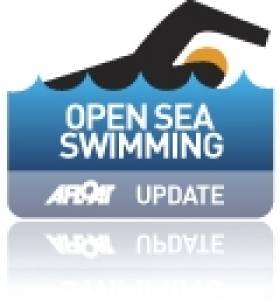Displaying items by tag: liffey
Liffey Laser Regatta Attracts 18 For Royal Alfred YC Dinghy Event
#liffeylasers – If you thought all the Irish Laser action was in the south of France this week, you'd be wrong. Paul MacMahon (Strangford/Howth), a previous number one on the domestic full rig rankings, is among 18 Lasers now entered for the Saturday's Royal Alfred Laser Challenge on the River Liffey. Other competitors heading for the captial's waters are a mix of younger guys graduating up from the 'Radial' rig and some senior 'Masters' including Theo Lyttle, Rob Cahill and Sean Craig.
As previously reported, the East Link Toll bridge lifts at 1015 for the Lasers, racing (as many races as possible) from 1100, bridge back up at 1500, then Poolbeg YC for the prizegiving.
Royal Alfred Yacht Club to Stage Laser Dinghy Event on Dublin's River Liffey
The Royal Alfred Yacht Club will hold a river Liffey racing event for the Laser dinghy class on Saturday 11th October. Dublin's East Link bridge is being opened at 10.30am to allow the passage of the fleet up the river and racing is due to start at 11.00.
Royal Alfred Yacht Club Commodore Barry MacNeaney reports there will be continuous races with a short lunch break until 15.00 and the bridge will open again at 14.30 to let the competitors return to the Poolbeg Yacht Club where refreshments will be available before the prize-giving. 'This format tests the skills of the sailors in an environment of narrow waters and changing winds and provides an extra dimension to the more normal sailing conditions they usually experience', says MacNeaney.
Entry forms are available for downloading on the Royal Alfred website from next Monday (29th September).
Cruise to Visit River Liffey's New Pontoons in Dublin City
#dublinport – Dublin Port Company have installed new permanent pontoons on the River Liffey at North Wall Quay (beside the O2). Dublin Port Company, Sail Training Ireland and the Irish Sailing Association have linked up with the Cruising Association of Ireland's yearly Liffey Cruise to create the Dublin Port Parade of Sail on Dublin Bay on the weekend of 27 & 28 September 2014.
The Cruising Flotilla coincides with Dublin Port Vintage Car Rally, 27th - 28th of September. The boating community isinvited to take part in a flotilla to officially open these pontoons, which are now available for use by vessels wishing to visit the Capital city.
More information on the cruise HERE.
A core Dublin Port aim of the cruise is to protect and develop Dublin's heritage as a port and maritime city. By partnering with the Cruising Association of Ireland and the Irish Sailing Association in this initiative it is hoped to further increase the level of boating activity on the River Liffey and to highlight the availability of the new North Wall Quay pontoons for visiting vessels.
Cruising Flotilla Itinerary
All boats gather in Dublin Bay Saturday 27th September
Parade of Sail up the River Liffey for a bridge lift
Over-Night berthing on the new pontoons
Reception with welcome drinks and buffet on board the Cill Airne Boat-Bar and Restaurant
Music entertainment including a Harpist
Departure on Sunday morning or afternoon
Tickets for buffet BBQ €20 per person.
Charlie Murphy, Communications Manager at Dublin Port announced "The purpose of this event is to promote the River Liffey as a destination for the boating community. The river has so much potential as a recreational resource for Dublin City. We hope that this event will increase awareness among the boating community that the River is a destination that welcomes them"
Vintage Car Rally
This event takes place all weekend and will see an array of vintage vehicles descend on Dublin Port for the annual Vintage Car Rally. There will be vehicles on show, transport sales and exhibition stalls; a vintage bus service touring Dublin Port. Funds from this event will go to support the excellent work undertaken by Barnardo's Ireland. Ticket prices: €4 for kids, €8 for adults & €20 for a family. More here.
Sail Training Ireland (S.T.IRL.) is the National Sail Training Charity, with President of Ireland, Michael D. Higgins as our Patron. The aim of S.T.IRL. is to provide access for Irish youths to sail training voyages at sea, regardless of background, social or financial constraints or ability. Since 2011 over 500 youths have undertaken voyages as a result of our work. Dublin Port Company and Dublin City Council are our main supporters. Members include: The Irish Naval Service, NMCI, Ports of Dublin, Drogheda, Cork and Galway, Spirit of Oysterhaven Trust. S.T.IRL. is a member of the ISA.
The Cruising Association of Ireland is a voluntary ISA-affiliated organisation. Working with the ISA, the ICC and other related organisations, it represents the interests of cruising sailors in Ireland, and promotes cruising among the wider sailing community via www.cruising.ie. The Liffey Cruise has been a regular feature of its calendar on the East Coast.
Dublin Port Company and Dublin City Council have signed an agreement with Sail Training Ireland to develop a local Dublin-based Sail Training Programme as a legacy to their partnership formed during the 2012 Tall Ships Festival. This is built on a platform of regenerating the River Liffey as a resource for the community of Dublin, integrating the community of Dublin and Ireland with the Port, the sea, maritime activities and maritime industries.
Rivers That Flow Through Our Cities Should Be Utilised
#thisislandnation – We don't make enough use of the rivers which flow through our cities. These ribbons of life to our major urban centres pass through the heart of the cities where the pressure of traffic and pedestrians shows more interest in the speed with which they can be crossed, often seeming to regard them as unwelcome blocks which require bridges, rather than appreciate that underneath those bridges is a system of transport and leisure which is neglected and often used by citizens for dumping of their waste.
There are some moves to utilise them more efficiently. On the Liffey there is a sightseeing tourist vessel and Poolbeg maintains its sailing presence close to the shipping sector. In Cork a voluntary organisation, Meitheal Mara, has promoted boating on the many different strands into which the city forces the Lee to pass through. Cork's city-based shipping operations have been diminished by the port which wants to end them altogether and move commercial shipping to Ringaskiddy where its public presence will be more limited and removed from the public eye. Waterford has based a marina in the city centre, but shunted its shipping to Belview where it is practically unseen by the public, so that the contribution of shipping to the economy is not perceived as strongly as it should be. Galway is a restricted tidal port, but a new one is planned and close enough to be seen by citizens. Dublin maintains port operations close to the city.
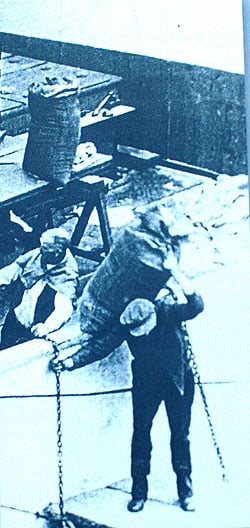
Dublin Port docker from the North Lotts book
There was a time when the ports and the rivers throbbed with life. In Dublin Guinness barges traversed the Liffey and there were real characters on the docks in all of our cities. Life could be tough as a dock labourer, but there was a great pride in the communities which lived around the ports and recognised the importance of shipping.
The East Wall has always been a proud Dublin community with seafaring a vital part of its tradition. On my programme THIS ISLAND NATION I played a song from a CD which was presented to me. 'Songs from the North Lotts' by Paul O'Brien capture a time in East Wall which deserves to be remembered. The East Wall Residents' Association which has been in existence for some fifty years, "maintaining and promoting the rare and wonderful community that it is an always has been," led the production of the book of the songs, dedicated to the people of East Wall and North Wall.
The song I played was "Taking the Boat," about which Paul O'Brien wrote in a book accompanying his CDs in 2009: "When I was growing up Dublin people didn't emigrate, they 'took the boat'. Single or married, it didn't matter. I don't personally know of any Dublin family that has not been touched by emigration."
There was a great response to the song, which you can hear on the Afloat website by CLICKING HERE. It was so good that in the June edition of the monthly programme, I will be playing another ballad from the collection – "Me Handsome Stevedore."
Tune in to hear it – next Wednesday night, June 4 at 7.30 pm on Youghal Radio – Community Radio Youghal 104FM or on their website www.cry104fm.com or if you are in the Dublin area, tune in to NearFM 90.3 on Friday night, June 6 at 6 p.m. This is another station joining the "family of the sea."
There was an interesting comment on the May edition of the programme by Jim O'Donovan, Director of Environment and Recreation with Cork City Council, who compared the better environmental condition of the River Lee to the Liffey, particularly around Heuston Station, about which he was quite critical.
Click HERE to listen to him on the Afloat podcast of the programme.
MARINE COMMUNITY GROWING
Waiting for the tide at Youghal in County Cork
Community radio stations around the country are showing great interest in the marine sphere and counteracting neglect by national and local commercial radio. I met many of these voluntary broadcasters at the annual meeting of their national organisation, CRAOL, over the past weekend in Youghal. They have produced and broadcast programmes on a wide variety of marine topics. THIS ISLAND NATION, was amongst the winners in the annual CRAOL national awards, chosen by the broadcasters themselves. I am pleased that the description "this island nation" is heard being more widely used in general conversation, by the media, in politics and in business. Awareness of the marine sphere is growing.
WHELKS, BIRDS AND FISHING
I didn't know a lot about the Irish sea snail which is worth around €4m. a year in exports until I talked to Liam Kennedy from the Sea Fisheries Protection Authority who wants fishermen to protect them. I will be broadcasting that interview in the June edition of THIS ISLAND NATION radio next week, as well as an exclusive interview with the Head of the SFPA, Susan Steele. She tells me that she wants to see "a thriving fishing industry and thriving fishing communities," but warns that those who "lose the run of themselves" and engage in illegal fishing will be dealt with speedily and effectively because they damage the future of the fishing industry. I will also be talking to Birdwatch Ireland about the arrival, for the first time, of one of the world's rarest sea birds off the Irish coast.
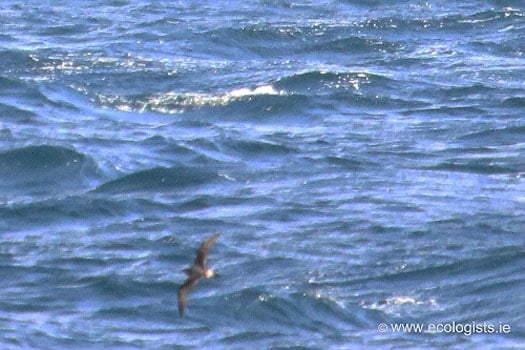
This is the Bermuda Petrel, an endangered species, of which there are only 108 breeding pairs known to exist.
WOMAN WITH CONFIDENCE
"We've never sailed in Cork before, but we're quite confident anyway." That's the view of the top woman match racing sailor, 32-year-old Camilla Ulrikkeholm from Denmark, who will be at the home of sailing, the Royal Cork YC in Crosshaven, for the ISAF Women's Match Racing World Championships will be staged there next week.
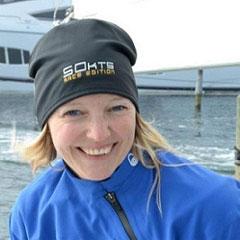
Camilla Ulrikkeholm from Denmark
The event will start on Tuesday and continue until Sunday, sailed in the ISA J80s fleet. "We've done a lot of research about the venue, we know the boat very well and we're definitely as tuned together as a crew should be. We'll just handle it the same way we usually do - arrive early to spend a day finding out all the practical details, then do some practising and get to know the boat and work our way into the regatta by using the first matches to learn about the local conditions."
That's confidence !
SHIPPING RECOVERY UNLIKELY
The Chief Executive of A.P.Moeller-Maersk Company has indicated that there will not be a sustainable recovery in the shipping industry in the short term. Nils Andersen is quoted as saying that "there is lingering overcapacity" which may remain until 2017. The Irish Maritime Development Organisation in its Weekly Market Review says that "the idle containership fleet" has gone below two per cent of the overall fleet for the first time since last September, but the global tanker market is experiencing low rates with the crude sector suffering particularly and providing only very low earnings for owners. The European Short Sea Bulk market is also experiencing a downward trend which has been developing since April.
BALTIMORE MARITIME COURSES
Baltimore Maritime Centre was formed in December 2013 by a nucleus of members of Les Glénans, following the closure of the Glenans sail training base in the village. It has acquired six of that organisation's keel boats and will start sailing courses this Summer in conjunction with Heir Island Sailing Schull and Baltimore Yacht Charters.
Twitter: @TomMacSweeney and @Afloatmagazine
#navy – Following a tender competition the first of two new ships for the Irish Navy arrived into Dublin for a naming ceremony at the weekend. See time lapse arrival of her arrival up the River Liffey above. As Afloat reported previously An Taoiseach and Minister for Defence Mr. Enda Kenny, T.D. attended the naming and commissioning ceremonies for the new Naval Service ship, LÉ Samuel Beckett beside the Samuel Beckett Bridge in Dublin city centre. The naming ceremony was carried out by a niece of Samuel Beckett, Mrs. Caroline Murphy. The second ship, James Joyce is to arrive in 2015.
The contract for the new ships was signed in October 2010, with Babcock Marine, part of the Babcock International Group, in the United Kingdom for the provision of two new offshore Patrol Vessels (OPVs) for the Naval Service to be built in Appledore, Devon, United Kingdom (same shipyard where both LÉ Roisin and LÉ. Niamh were built over a decade ago).
The new ships are larger vessels than LÉ Roisin and LÉ Niamh with a length of 89.5m.The cost of the two new ships is €108m, exclusive of VAT.
This is a replacement programme – LÉ Samuel Beckett replaces LÉ Emer which was decommissioned and sold late last year. The ship will be used mainly for fishery protection patrols.
LÉ Samuel Beckett arrived home to the Naval Base, Haulbowline, Cork on Wednesday 30th April 2014. The ships first captain is Commander Ken Minehane from Bantry. The ship will have a main crew of 44.
Work on the second ship (LÉ James Joyce) is well advanced and it should be completed early in 2015. LÉ James Joyce will replace LÉ Aoife.
Brief Specification of the LE Samuel Beckett
|
Class of Ship |
Offshore Patrol Vessel |
|
Length |
89.5 metres |
|
Beam |
14 metres |
|
Draft |
3.8 metres |
|
Max Speed |
23 knots |
|
Propulsion |
2 x Wartsila Diesel Engines, 2 shafts, 10000kw |
|
Accommodation |
44 crew plus 10 trainees |
|
Main Weapons |
1 x 76mm Oto Melara Compact Naval Gun 2 x 20mm RH 202 Rheinmetall Cannon 2 x 12.7mm Heavy Machine Gun’s 4 x 7.62mm General Purpose Machine Gun’s
|
UCD Rowers Win Terrific Gannon Cup Race
#ROWING: UCD won the Gannon Cup for senior men after a terrific struggle, while Trinity senior women took the Corcoran Cup in facile fashion at the Colours Rowing Races on the Liffey today.
Trinity’s crew led the Gannon Cup race from just after the start, but could not gain a clearwater lead. UCD’s pushes were relentless, and though they were still behind coming through the final bridge, Watling Street, they then powered through and had command of the race when Trinity’s number four man and captain, Luke Acheson, collapsed. The race was not rowed out. It took a long time – too long - to get Acheson into an ambulance, as he had to be brought up the river all the way to City Quay before being lifted up the steps. He was being treated in St James’s Hospital this afternoon.
Trinity’s Corcoran Cup crew demonstrated that size is not everything in rowing. They were outsiders, but simply rowed better than UCD. They eked out an early lead and built it steadily into an unassailable margin by the end.
UCD’s annexation of the Sally Moorhead Trophy for novice women was also one-sided, but Trinity took the novice men’s title after UCD suffered a boat-stopping crab right in front of the Four Courts. UCD came back to lead briefly, but Trinity took control again before the finish.
Colours Rowing Races, O’Connell Bridge to St James’s Gate
Men – Senior (Gannon Cup): UCD (M Bailey, W Yeomans, C O’Riada, B Crosse, D O’Neill, A Griffin, P Moore, N Kenny (stroke); cox: L Mulvihill) bt Trinity not rowed out. Novice (Dan Quinn Shield): Trinity bt UCD 1 ½ l.
Women – Senior (Corcoran Cup): Trinity (G Crowe, H O’Neill, H McCarthy, R Deasy, S O’Brien, A Leahy, S Cass, R Morris (stroke); cox: N Williams) bt UCD easily.
Novice (Sally Moorhead Trophy): UCD bt Trinity easily.
UCD Rowers Target Seventh Consecutive Gannon Cup
The Gannon Cup Committee have announced the arrangements for the 2014 Dublin University Boat Races between Trinity College Dublin and University College Dublin. The Colours rowing races will this year take place on Sunday, March 16th, in association with the official St Patrick’s Festival. The races will be contested on the River Liffey from O’Connell Bridge to St James’ Gate Brewery. The senior men's race (The Gannon Cup) is set for 11 o'clock and the senior women's race (Corcoran Cup) 10.30. The programme will commence at 9:30am with the novice women racing for the Sally Moorhead Trophy, followed by the novice men’s race for the Dan Quinn Shield at 10am.
A winter of extreme weather conditions has led to the cancellation of the majority of Rowing Ireland events, making it hard to predict the outcome of what promises to be a very exciting series of races.
For Susannah Cass, who will row in the seven seat of Trinity's Corcoran Cup crew, this is just the first test in a summer of rowing adventures. Susannah will be racing across the Irish Sea in the Celtic Challenge race in May, before competing in the world’s first Pacific Ocean rowing race – a 2,400 mile challenge from California to Hawaii. Meanwhile, in the UCD crew, the Gilligan sisters will be hoping to keep the Corcoran Cup in the family, as Aoife enlists her sister Ruth’s help in defending the title.
The senior men's race will have its 66th staging on Sunday. The Gannon Cup was founded in 1947 in memory of former UCD captain Ciarán Gannon, who lost his life serving in the Royal Army Medical Corps in Burma in 1944. There were no races in 1957 and 1958. UCD have dominated the event in recent years and will be hoping to make this their 7th consecutive win with the help of a strong crew of promising young athletes including World Under-23 silver medallist Niall Kenny. Trinity hope the return of coach Nick Dunlop, whose record includes a number of convincing Gannon Cup wins, turns the UCD tide.
Trinity won the coin toss hosted at Leinster House by Taoiseach Enda Kenny. They chose to race on the north station in both the men’s and women’s races.
The university boat races are an annual event on the River Liffey echoing the world famous Oxford/Cambridge University Boat Race in London. In 1980 Trinity were presented with the Corcoran Cup as winners of the inaugural women’s boat race; however, UCD responded strongly to this initial defeat and currently lead the series by 21 wins to Trinity’s 13. Races for novice men and women were introduced in 2004 and 2005 respectively.
Spectator buses will follow the races and depart from the O’Connell Bridge.
Program of events:
9:30am The Moorhead Trophy – Novice Women (holder Trinity)
10:00am The Dan Quinn Perpetual Shield – Novice Men (holder UCD)
10:30am The Corcoran Cup – Senior Women (holder UCD)
11:00am The Gannon Cup – Senior Men (holder UCD)
#grandcanal – Waterways Ireland advises owners and masters that due to essential electrical and mechanical maintenance the Sea Lock at Ringsend (Buckingham Lock) is closed to navigation until further notice. This will prevent boat passage between Grand Canal Basin and the River Liffey whilst maintenance works are ongoing.
As works progress it may be possible to make passage by prior arrangement, but this will be entirely dependent on the stage of works. If wishing to make arrangement please contact the Dock Superintendent, Mark Clarke, on 087 258 4713, who will be able to advise accordingly.
City Kayaking Announces Limited '€5 For Youth Groups' Offer
#Kayaking - Dublin-based urban kayaking operator City Kayaking has announced it has secured funding to help subsidise kayaking excursions for youth groups in the capital.
The company is now running a limited '€5 Kayaking for Youth Groups' offer to get Dublin kids on the water on kayaks from just €5 per head.
According to the website, the sessions on the River Liffey will be instructor-led in double-seater kayaks providing the best in comfort, stability in safety, so no prior experience is necessary!
For details visit the City Kayaking website HERE - and act fast, as places for these special trips are strictly limited.
Liffey Swim Event Sees 335 Take to the Capital's Waters
#liffeyswim– The River Liffey glistened today as 335 men and women of all ages took to the water for the 94th Dublin City Liffey Swim, supported by Dublin City Council and staged by The Open Sea Committee.
219 men battled it out in the men's race that kicked off at 12.30pm at the Loop Line Bridge. Ciaran O'Driscoll from Half Moon Swimming Club in Great South Wall in Dublin won the men's race with an impressive time of 26.16 minutes. The women's race followed an hour later when 116 women took to Ireland's most famous river for their chance to swim competitively through the heart of Dublin city. Gina Murphy from Glenalbyn Masters in Stillorgan, Co Dublin crossed the winning line at the East Link Toll Bridge after only 32.22 minutes.
A special presentation with the Lord Mayor took place on the Cill Airne at 3.15pm when the winners were awarded their winners cups as well as a print of the historic 1923 Jack B Yeats painting titled "The Liffey Swim."
Speaking about the historic race, the Lord Mayor Oisín Quinn commented, "The Dublin City Liffey Swim has been growing in attendance year on year which illustrates just how important the legacy of the race is after 94 years. I would like to congratulate Ciaran and Gina as they have their names added to the historical list of Dublin City Liffey Swim winners. This year Dublin City Council is delighted to be in a position to provide additional support to this fantastic sporting event with the introduction of the first Liffey Living Festival and we hope that everyone that has attended the swim and festival has enjoyed an exhilarating free family day out."
The infectious atmosphere of the swim was carried on in "The Liffey Living Festival" presented by Dublin City Council in Grand Canal Dock where they were treated to an evening of free family activities such as giant sized street games, a live band "The Ships", ambient DJ and a specially erected floating open-air cinema, showing the classic movie "The Swimmer"!





























